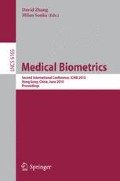Abstract
Atrial Fibrillation is the most common sustained arrhythmia encountered by clinicians. Because of the invisible waveform of atrial fibrillation in atrial activation for human, it is necessary to develop an automatic diagnosis system. 12-Lead ECG now is available in hospital and is appropriate for using Independent Component Analysis to estimate the AA period. In this research, we also adopt a second-order blind identification approach to transform the sources extracted by ICA to more precise signal and then we use frequency domain algorithm to do the classification. The strategy used in this research is according to prior knowledge and is different from the traditional classification approach which training samples are necessary for. In experiment, we gather a significant result of clinical data, the accuracy achieves 75.51%.
Access this chapter
Tax calculation will be finalised at checkout
Purchases are for personal use only
Preview
Unable to display preview. Download preview PDF.
References
Lin, Y.J., Liu, Y.B., Chu, C.C.: Incremental changes in QRS duration predict mortality in patients with atrial fibrillation. PACE - Pacing and Clinical Electrophysiology 32, 1388–1394 (2009)
Hunt, S.A., Baker, D.W., Chin, M.H., Cinquegrani, M.P., Feldman, A.M., Francis, G.S., Ganiats, T.G., Goldstein, S., Gregoratos, G., Jessup, M.L., Noble, R.J., Packer, M., Silver, M.A., Stevenson, L.W., Gibbons, R.J., Antman, E.M., Alpert, J.S., Faxon, D.P., Fuster, V., Jacobs, A.K., Hiratzka, L.F., Russell, R.O., Smith Jr., S.C.: ACC/AHA guidelines for the evaluation and management of chronic heart failure in the adult: Executive summary. A report of the American College of Cardiology/American Heart Association Task Force on Practice Guidelines (Committee to Revise the 1995 Guidelines for the Evaluation and Management of Heart Failure). Journal of the American College of Cardiology 38, 2101–2113 (2001)
Alcaraz, R., Rieta, J.J.: A review on sample entropy applications for the non-invasive analysis of atrial fibrillation electrocardiograms. Biomedical Signal Processing and Control (2009)
Fuster, V., Rydén, L.E., Cannom, D.S., Crijns, H.J., Curtis, A.B., Ellenbogen, K.A., Halperin, J.L., Le Heuzey, J.Y., Kay, G.N., Lowe, J.E., Olsson, S.B., Prystowsky, E.N., Tamargo, J.L., Wann, S., Smith Jr., S.C., Jacobs, A.K., Adams, C.D., Anderson, J.L., Antman, E.M., Hunt, S.A., Nishimura, R., Ornato, J.P., Page, R.L., Riegel, B., Priori, S.G., Blanc, J.J., Budaj, A., Camm, A.J., Dean, V., Deckers, J.W., Despres, C., Dickstein, K., Lekakis, J., McGregor, K., Metra, M., Morais, J., Osterspey, A., Zamorano, J.L.: ACC/AHA/ESC 2006 guidelines for the management of patients with atrial fibrillation: A report of the American College of Cardiology/American Heart Association Task Force on practice guidelines and the European Society of Cardiology Committee for practice guidelines (Writing committee to revise the 2001 guidelines for the management of patients with atrial fibrillation). Circulation 114, e257–e354 (2006)
Stridh, M., Sörnmo, L.: Spatiotemporal QRST cancellation techniques for analysis of atrial fibrillation. IEEE Transactions on Biomedical Engineering 48, 105–111 (2001)
Hamilton, P.S., Tompkins, W.J.: Compression of the ambulatory ECG by average beat subtraction and residual differencing. IEEE Transactions on Biomedical Engineering 38, 253–259 (1991)
Castells, F., Rieta, J.J., Millet, J., Zarzoso, V.: Spatiotemporal blind source separation approach to atrial activity estimation in atrial tachyarrhythmias. IEEE Transactions on Biomedical Engineering 52, 258–267 (2005)
Huang, Z., Chen, Y., Pan, M.: Time-frequency characterization of atrial fibrillation from surface ECG based on Hilbert-Huang transform. Journal of Medical Engineering and Technology 31, 381–389 (2007)
Addison, P.S., Watson, J.N., Clegg, G.R., Steen, P.A., Robertson, C.E.: Finding coordinated atrial activity during ventricular fibrillation using wavelet decomposition. IEEE Engineering in Medicine and Biology Magazine 21, 58–61+65 (2002)
Langley, P., Bourke, J.P., Murray, A.: Frequency analysis of atrial fibrillation. In: Computers in Cardiology, pp. 65–68 (2000)
Garcia, T.B., Holtz, N.E.: Introduction to 12-Lead ECG: The Art of Interpretation. Jones and Bartlett Publishers (2001)
Rieta, J.J., Castells, F., Sánchez, C., Zarzoso, V., Millet, J.: Atrial activity extraction for atrial fibrillation analysis using blind source separation. IEEE Transactions on Biomedical Engineering 51, 1176–1186 (2004)
Rieta, J.J., Zarzoso, V., Millet-Roig, J., García-Civera, R., Ruiz-Granell, R.: Atrial activity extraction based on blind source separation as an alternative to QRST cancellation for atrial fibrillation analysis. In: Computers in Cardiology, pp. 69–72 (2000)
Comon, P.: Independent component analysis, A new concept? Signal Processing 36, 287–314 (1994)
Hyvärinen, A., Oja, E.: Independent component analysis: Algorithms and applications. Neural Networks 13, 411–430 (2000)
Thakor, N.V., Zhu, Y.S.: Applications of adaptive filtering to ECG analysis: Noise cancellation and arrhythmia detection. IEEE Transactions on Biomedical Engineering 38, 785–794 (1991)
Belouchrani, A., Abed-Meraim, K., Cardoso, J.F., Moulines, E.: A blind source separation technique using second-order statistics. IEEE Transactions on Signal Processing 45, 434–444 (1997)
Jager, F., Moody, G.B., Taddei, A., Mark, R.G.: Performance measures for algorithms to detect transient ischemic ST segment changes. In: Computers in Cardiology, pp. 369–372 (1992)
Kara, S., Okandan, M.: Atrial fibrillation classification with artificial neural networks. Pattern Recognition 40, 2967–2973 (2007)
Chang, P.C., Hsieh, J.C., Lin, J.J., Chou, Y.H., Liu, C.H.: Hybrid System with Hidden Markov Models and Gaussian Mixture Models for Myocardial Infarction Classification with 12-Lead ECGs. In: 11th IEEE International Conference on High Performance Computing and Communications, HPCC 2009, Seoul, pp. 110–116 (2009)
Author information
Authors and Affiliations
Editor information
Editors and Affiliations
Rights and permissions
Copyright information
© 2010 Springer-Verlag Berlin Heidelberg
About this paper
Cite this paper
Chang, PC., Hsieh, JC., Lin, JJ., Yeh, FM. (2010). Atrial Fibrillation Analysis Based on Blind Source Separation in 12-Lead ECG Data. In: Zhang, D., Sonka, M. (eds) Medical Biometrics. ICMB 2010. Lecture Notes in Computer Science, vol 6165. Springer, Berlin, Heidelberg. https://doi.org/10.1007/978-3-642-13923-9_31
Download citation
DOI: https://doi.org/10.1007/978-3-642-13923-9_31
Publisher Name: Springer, Berlin, Heidelberg
Print ISBN: 978-3-642-13922-2
Online ISBN: 978-3-642-13923-9
eBook Packages: Computer ScienceComputer Science (R0)

